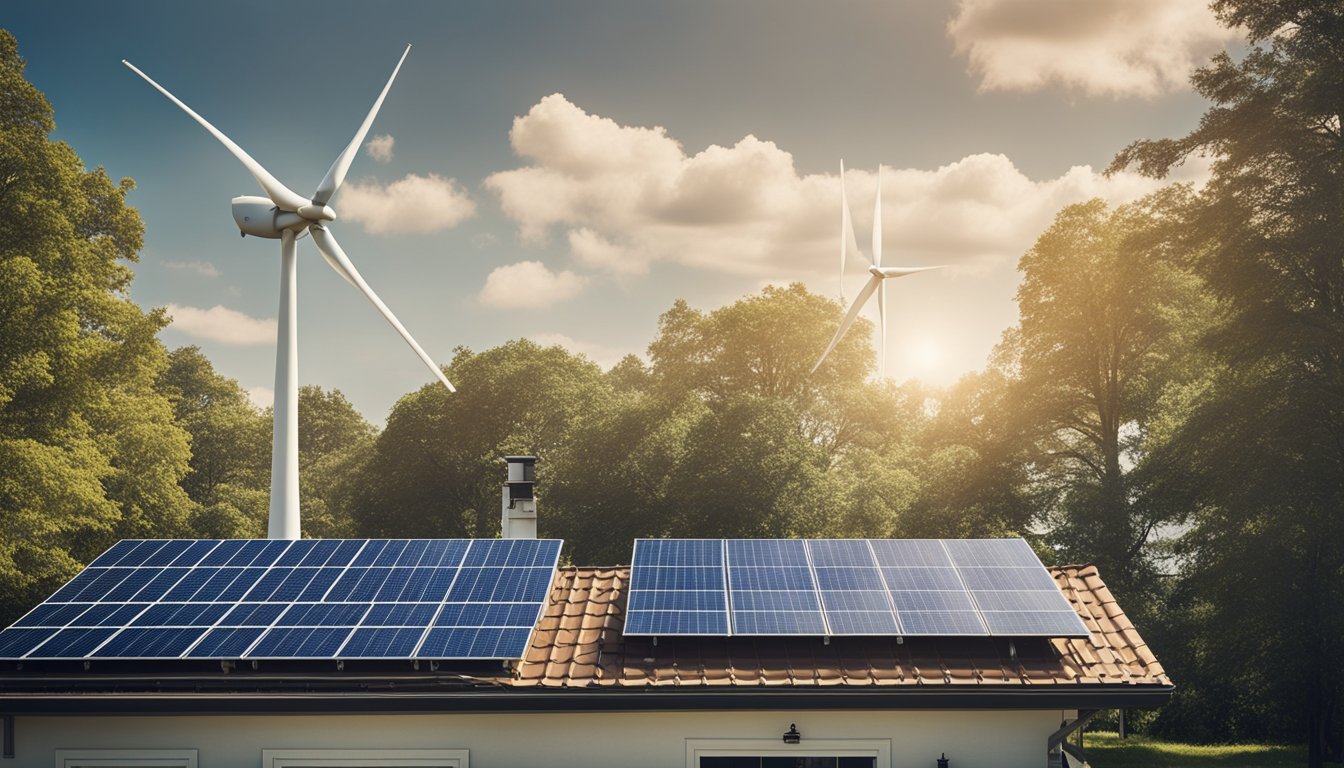Late updated: 15 Feb 2025 13:02
Written by: Amber Collins
Reducing Carbon Footprint With Renewable Energy: A Path to Sustainable Living
Embarking on a journey to reduce our carbon footprint can seem daunting, but it is essential for combating climate change. One of the most effective ways we can contribute to this global effort is by harnessing renewable energy. Switching to renewable energy sources like solar, wind, and hydroelectric power significantly decreases our reliance on fossil fuels, which are major contributors to carbon emissions.

Exploring our energy options is not just about making a personal impact; it is about supporting the energy transition needed on a global scale. By promoting energy efficiency and investing in renewable technologies, we take a crucial step towards a sustainable future. Together, we can make informed choices that lead to meaningful change.
Key Takeaways
- Renewable energy can substantially lower carbon emissions.
- Embracing renewable technologies accelerates the energy transition.
- Individual choices in energy use impact the global climate effort.
Renewable Energy Sources and Technologies
In our pursuit of reducing carbon footprint through renewable energy, several technologies stand out. From harnessing wind power to innovating with hydrogen, each has unique attributes and applications. This section explores the specifics of these renewable energy solutions, emphasising their significance in a sustainable future.
Wind and Solar Power
Wind and solar power play a crucial role in our renewable energy landscape. Offshore wind farms harness powerful wind currents, offering a high capacity for energy generation. Wind turbines are becoming more efficient, reducing costs and increasing accessibility.
Solar power, driven by advances in solar panels, captures sunlight and converts it into electricity. Photovoltaic technology improvements enhance efficiency, making solar one of the fastest-growing renewable sources. By integrating solar panels into existing infrastructure, such as rooftops, we maximise energy capture while reducing reliance on fossil fuels. This shift contributes significantly to cleaner energy systems, aiding decarbonisation efforts.
Hydropower and Geothermal Energy
Hydropower is a foundational element in our pursuit of low-carbon energy solutions. By utilising water flows, hydropower stations generate substantial amounts of renewable power. Recent innovations focus on minimising environmental impacts while increasing electricity output. As a dependable energy source, hydropower helps stabilise our energy grid, supporting sustainability and reducing greenhouse gas emissions.
Geothermal energy taps into the Earth's natural heat, providing a consistent and reliable power source. Utilising heat pumps to extract this energy, geothermal technology offers efficient heating and cooling solutions. As geothermal plants are developed in more regions, the potential for this green energy solution continues to grow, enhancing our ability to reduce carbon dioxide emissions in the energy sector.
Biomass Energy and Hydrogen
Biomass energy derives from organic materials, converting plant and waste matter into electricity, heat or fuels. By repurposing agricultural by-products and other organic waste, biomass supports a circular economy. It aids in greenhouse gas reduction by capturing carbon dioxide emitted during combustion processes.
Hydrogen, especially green hydrogen, is gaining momentum as a clean energy alternative. Produced using renewable electricity, it generates power without emitting carbon. Hydrogen can be used in transport, industry, and as part of broader energy systems. As we innovate in this space, hydrogen offers promising potential for decarbonisation, contributing to a cleaner, more sustainable future.
Nuclear Energy
Nuclear energy remains a pivotal component of low-carbon strategies. With the ability to produce large amounts of power with minimal emissions, nuclear plants are key to reducing carbon footprints. The latest advancements in reactor safety contribute to sustainable operations, allowing nuclear energy to support renewable power generation efforts.
A crucial benefit of nuclear energy is its reliability and capacity to provide stable base-load power, complementing intermittent renewable sources like solar and wind. Continued investment and development in nuclear technology ensure it remains a central part of our clean energy transition, mitigating climate impact and supporting long-term environmental goals.
Strategies for Reducing Carbon Footprint

Addressing carbon emissions is crucial in combating climate change. Key strategies involve transforming our transportation systems, enhancing building efficiency, shaping policy, and embracing societal shifts towards sustainability. Each plays a vital role in promoting renewable energy and reducing reliance on fossil fuels. We need to explore these areas to harness their full potential.
Transportation and Electric Vehicles
Transportation significantly contributes to greenhouse gas emissions due to heavy reliance on fossil fuels. Switching to electric vehicles (EVs) can reduce this impact. EVs use electricity, which can be sourced from renewable energy, lowering air pollution and carbon emissions. Expanding public transport infrastructure provides sustainable alternatives to car travel. Investing in cycling paths and pedestrian-friendly urban design encourages eco-friendly commuting. These steps can help transition us towards a cleaner, sustainable future.
Building Efficiency and Smart Design
Building efficiency is crucial for reducing carbon footprints. Proper insulation and advanced designs, such as green roofs, significantly curb energy waste. Heat pumps and energy-efficient appliances reduce the need for core energy sources like coal and natural gas. Smart building designs incorporate renewable energy sources and energy management systems, enhancing resource use. By prioritising energy-efficient construction, we can minimise our impact on the environment.
Policy and International Efforts
International agreements, like the Paris Agreement, aim to curb global warming by reducing reliance on carbon-based fuels. Organisations like the International Energy Agency focus on increasing renewable energy through policies and subsidies. Government incentives for green technology investments encourage adoption and innovation in sustainable energy solutions. By working together, nations can create stronger frameworks to support renewable energy growth, leading to a net zero future.
Societal Changes and Sustainability
Societal shifts towards sustainability greatly impact carbon footprints. Embracing sustainable practices promotes conscious consumption and biodiversity preservation. Encouraging gender equality can drive diversified approaches to tackling climate challenges. Education and awareness foster community involvement in renewable practices. By working collectively, we can implement changes that boost global sustainability efforts and reduce overall carbon emissions.
Frequently Asked Questions

Our focus is on how renewable energy can play a transformative role in both reducing carbon emissions and preserving the environment. We examine several aspects of renewable energy's impact, from advantages to its efficiency in minimising pollutants.
What are the main advantages of utilising renewable energy?
Renewable energy sources such as solar, wind, and hydropower offer significant advantages. These include reduced dependency on fossil fuels, lower carbon emissions, and increased sustainability. Renewable technologies also tend to involve lower operational costs over time.
In what ways can renewable energy contribute to environmental preservation?
These energy sources help preserve natural habitats by reducing pollution and the need for resource extraction. They also support biodiversity by minimising the impact on ecosystems and decreasing the carbon footprint related to energy production and consumption.
To what extent does renewable energy contribute to the reduction of greenhouse gas emissions?
Renewable energy considerably reduces greenhouse gas emissions by displacing fossil fuel-based energy production. Transitioning to renewables is key in achieving lower emissions, as they generate power without emitting carbon dioxide.
Which source of renewable energy is considered the most efficient in minimising carbon emissions?
Solar and wind power are generally the most efficient in reducing carbon emissions. Both technologies generate electricity with minimal carbon footprint and have seen significant technological advances, making them cost-effective and efficient.
How does energy conservation complement the use of renewable energy in lessening carbon footprints?
Energy conservation reduces demand, allowing us to make better use of renewable resources. This practice enhances the efficiency of both generation and consumption, creating a more balanced and sustainable energy system.
What specific impacts have renewable energy technologies had on reducing air and water pollution?
Implementing renewable energy technologies has notably decreased air pollutants, such as sulphur dioxide and nitrogen oxides. Water pollution has also been reduced due to the diminished need for water in processes like cooling in power plants, making renewable energy a cleaner option for the environment.
